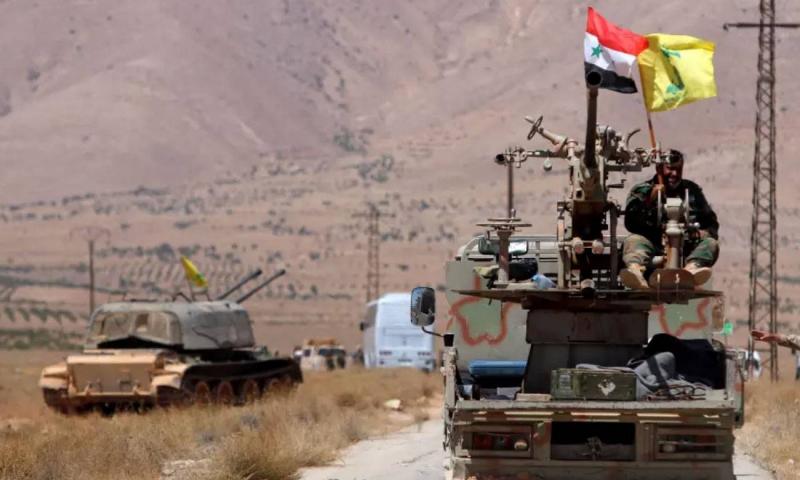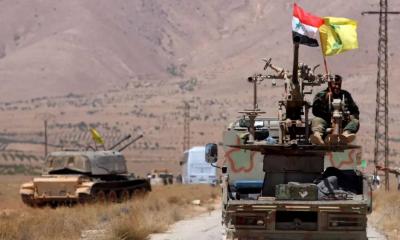A report by "Independent Arabia" on Friday counted the Iranian-aligned Iraqi factions present in Syria, describing them as the "backbone" of the Iranian Revolutionary Guard's power. The report mentioned that "preliminary information indicates that pro-Iran groups, particularly the Iraqi ones, are enhancing their capabilities, representing the backbone of the Iranian Revolutionary Guard's striking force against the American presence in Syria." Among these factions is "Hezbollah Brigades" of Iraq, which numbers around 7,000 fighters and cooperates with the Lebanese "Hezbollah," which arrived in Damascus in 2013.
The "Abu al-Fadl al-Abbas Brigade" holds an important and advanced position, with a fluctuating number of fighters, in addition to "Nujaba Movement," which fought alongside the Syrian regime's army in Aleppo and Damascus. "Asa'ib Ahl al-Haq" factions are spread across the rural areas of Damascus and al-Bukamal, alongside "Saraya Talai al-Khorasani," which has nearly five thousand armed fighters in Iraq and Syria. Other known factions include "Muhammad Baqir al-Sadr Forces," "Imam Hussein Brigade," "Zulfiqar Brigade," and "Velayat al-Faqih Corps," according to the report.
The Syrian Observatory for Human Rights estimates the total number of foreign forces in Syria, including Iraqis, Afghans, and Pakistanis, to be around 15,000 fighters as of last year, 2013. Meanwhile, the "Jusur" center and "Informagen" data analysis institute estimated that the number of Iranian factions that participated in the Syrian war since 2012 reached about 100,000 fighters under the banner of 70 military groups, distributed across 50 bases and around 500 military points.
The map of Iranian-supported forces' deployment indicates the presence of 28 to 30 sites in southern Syria, with a military brigade protecting sensitive strategic warehouses. The Syrian Observatory documents 55 bases in addition to 515 military points located in Deir Ezzor, al-Bukamal, and Mayadeen in eastern Syria, as well as in the Homs desert and its countryside on the Syrian-Lebanese border, the countryside of Aleppo, southern Damascus, Daraa, and Quneitra, as well as the Sayyida Zainab area and around the capital.
The report notes that eastern Syria is witnessing a dangerous escalation between American forces and Iranian-aligned factions following mutual drone attacks, which threatens the outbreak of a war that could widen, especially with the potential for an Iranian attack in retaliation for the assassination of Hamas political bureau chief Ismail Haniyeh in Tehran on July 31.
The tensions between the two sides in the Syrian desert come at a time when a possible Iranian response is expected to resemble the response to the Israeli bombing that targeted the Iranian embassy in Damascus on April 1, where Tehran merely sent hundreds of precision missiles and drones without hitting sensitive targets in Tel Aviv or its surroundings.
Since that time, Revolutionary Guard generals have been threatening retaliation for the assassination of their political guest, Haniyeh, at his residence in one of the presidential resorts, while "Hezbollah" is preparing for the zero hour of the Iranian response, motivated by a desire for revenge for the assassination by "Mossad" of a prominent leader within its ranks, Fouad Chakir, in the southern suburbs of Beirut.
On August 15, Iranian Revolutionary Guard leader Hossein Salami revealed the death of Colonel Ahmad Reza Afshari from the air advisory forces in Syria, succumbing to his injuries from an airstrike carried out by the international coalition, according to the semi-official Iranian news agency Fars. It is likely that Iranian officer Afshari was targeted in late July or early August, but reports did not specify where the strike occurred.
The U.S. Department of Defense (Pentagon) announced that eight American soldiers were injured in a drone attack on a U.S. base. Pentagon spokesman Patrick Ryder stated during a press conference on August 13 that three soldiers have returned to duty while eight others received necessary treatment for brain injuries and smoke inhalation. The United States believes that the attack was carried out by Iran-backed forces and is working to identify these forces.
Reuters reported that the U.S. soldiers sustained minor injuries, citing an American official. This incident marks the largest and second of its kind in recent days. The attack on the Rimelan base in northeast Syria was executed using a drone, while six personnel from Iran-aligned factions were killed in a drone strike in the eastern region.
### Preliminary Battles
In the meantime, Iranian-related factions alongside the Revolutionary Guard have already engaged in preliminary battles against the international coalition and U.S.-backed Syrian Democratic Forces (SDF). Opening a front in eastern Syria, particularly in Deir Ezzor province, is crucial as it is a shared power area among multiple forces, with Iranian influence in the eastern countryside. The al-Bukamal and Mayadeen areas situated along the Iraqi border serve as the main stronghold for the Revolutionary Guard.
Observers suggest that if the battle expands following the Iranian response to Israel and the southern Lebanon is subjected to a concentrated military offensive, "Hezbollah" might withdraw its groups, which would impact the number of fighters and experts in eastern Syria.
### Compensating for Shortages
Iran is reportedly looking to compensate for shortages by bringing in fighters of various nationalities, including Iranians, Afghans, and Iraqis, so as not to leave the Syrian arena vacant, according to Iranian affairs researcher Saad Al-Shar'a.




